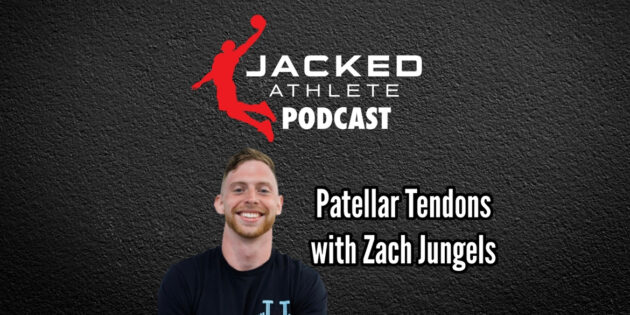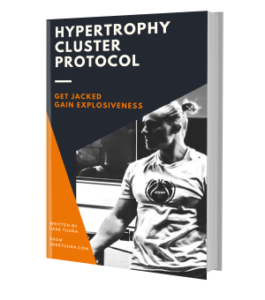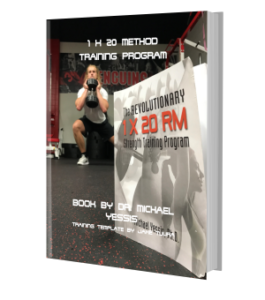https://podcasts.apple.com/us/podcast/jacked-athlete-podcast/id1462537296?i=1000705853223
“There was a lot of periods of high workload, low workload… and I just went straight back into running routes again. And I remember I ran a go route and I look back, jump up for the ball, catch the ball, land. And I felt this searing pain in my knee. I’ll never forget it.”
“I go to the trainer, the trainer starts yanking on my knee. They’re like, hey, I don’t think there’s anything wrong here. ⁓ Just take some time off. We think you’ll be good. So then four weeks in a boot doing nothing, back to three more weeks sitting on the couch, not doing shit. Now, I was hoping to crack the starting lineup. So when summer workouts roll around, I’m starting to lift and run routes and do running with the team again. And I’m realizing my knee hurts every time I bend this thing, every time I walk downstairs, every time I go to decelerate, change direction. It doesn’t hurt when I sprint full speed, but all those other things hurt so bad, especially decelerating and landing from jumping.”
“My knee hurts doing everything. It keeps getting worse. And I fall into the trap of taking a lot of time off. Knee feels better. Spike in the workload again. Burn the toast. And just over and over and over through this cycle.”
Rehab: “It was like six weeks of just doing step downs and it sucked. It hurt so bad. The only thing that she was able to progress me to with no pain was jogging on a treadmill and doing little like pogos and stuff.”
Rehab: “I was feeling every exercise in the joint and not in the muscle. And it was, it just wasn’t getting me anywhere.”
“This stage one was like my silver bullet because every time I did it, I go hold that leg extension. I go hold that David Gray foam roller bridge, that split squat and that single leg stand, and then I can actually go and practice.”
“I have this leg extension ISO that gives me an analgesic effect to where I can practice and be able to practice every single day with the team.”
Decline board single leg squats: “I could get a few degrees and my knee would start to hurt. It was just spamming those step downs like three sets, 15 reps just over and over again for three weeks, four weeks at a time. And then there were other variations that you’d have me doing like skater squats and all this other stuff where I would just load the absolute piss out of my hips and not bend my knee at all or try not to bend my knee at all. And so, yeah, it was was just all in the joint, nothing in the muscle, tons of banded clamshells. For some reason, the glute med just gets brutalized by physical therapists. just anytime it’s knee stuff, they’re like, you’re doing these monster walks and this will help you.”
Traditional rehab with a physical therapist: “It made me doubt the entire physical therapy system because what they would do is I would I saw three different physical therapists what they would do is they would go into their computer and they would type in your symptoms and they print out a list of exercises and I remember going to two different places and they gave me the same list of exercises and I tried to tell the second guy like, listen, dude, this didn’t work. I tried this for two months and it didn’t work. Like, what are we doing here? Give me some new exercises or something, please. Like, think about this a different way.”
Getting coaches to allow for rehab: “Number one, I had a niche skill set. I was a little bit faster, a little bit more explosive than some of the other people that were playing my position. So I had some value there. They told me, they’re like, hey, you’re gonna have a spot as long as you can just please get healthy. And so when I came to them and I, what I did was I wrote up a Google Doc and I laid out everything that I was gonna do. And I was like, listen, this is what I think is going to get me healthy. And he’s like, man, I don’t care. Like, dude, do whatever you have to do.”
Rehabbing while practicing sport: “And this is a big problem for athletes, but you have to understand, you have to have constant communication with your coaches. And you both have to be on the same page because if your coach doesn’t understand, then they’re just going to think you’re soft and they’re going to think you’re sitting out for no reason. And that’s not going to help your case at all.”
“The worst thing about patellar tendinopathy is that it’s just bad enough to where you almost always feel it in any sort of knee bending, gradual knee bending, and then you really feel it when you jump and you change direction and stuff. But it’s not so bad that you can’t do anything, right? You feel like you can go because when you warm it up a little bit, it’s not as bad. It’s still bad, it’s still there, but it’s not as bad, right? So that continues to push you to think, okay, maybe I’m being soft because I’m not breaking, but it feels bad every time I do this and this and this. So what I ended up doing was adjusting the way I did almost everything… I developed a more hinge strategy to accompany my knee pain.”
“That was definitely a hurdle for my coaches to understand like, okay, you can do 20 reps today, but tomorrow you can only do two. I just don’t understand how you can go from being so, feeling so good to feeling so bad. And they would always tell me, Zach, you’re so up and down. Like, I would have my emotions attached to how I felt, ⁓ how my knee felt that day, right? Again, this is sort of the psychological aspect of how patella tendinopathy kind of messes with your mind. ⁓ I wasn’t able to like regulate my emotions. So like, I would be, I would have knee pain really, really bad. My tendon would blow up and then I’d be all sad and in a bad mood and be mad and shit. And then my tendon would be feeling good and I’d be, yeah this is great. Let’s go throw down some dunks and, you know, run a bunch of routes today. And so when you’re feeling good, you’re always going to push it more. But when you’re feeling bad, you always feel like it’s the worst thing ever and it can only get worse from here.”
“So it was kind of always just looking forward to the next day or the next training session and being like, how far is that training session away? How many reps can I do today? And it was just following those time periods of 24 hours, 48 hours, 72 hours. We’re going to be better then. So just respecting those time periods was very hard and when you don’t understand that, you’re always going to make it worse.”
Isometrics: “It was almost like my routine I would have to go into the weight room and hold an isometric. But once I stopped feeling symptoms in my knee, I stopped holding the ISOs and just ever since then it’s never came back unless I go and I spike my workload a little bit and then it kind of, you know, it’s bugs me for a few days and then it just goes away after I, you know, do the things that I need to do.”
“I think almost all rehab programs, where they commonly fail is they don’t have enough intensity. They don’t find the highest possible entry point. They might not have enough proper volume of things that don’t bother them.”
“And as long as you follow pain and function through your progressions, I don’t think you can do a lot of wrong.”
Zach on Instagram: https://www.instagram.com/jungels_sp/
Zach’s Linktree: https://linktr.ee/jungels_sp?fbclid=PAZXh0bgNhZW0CMTEAAacaGkjqM3BtO2cpjzsTeWTR24xN3RkpRLYohZUrVD4rFi8g4IY_rdU4khXRvA_aem_sF_ViokbqzsuGox7wTep8w



